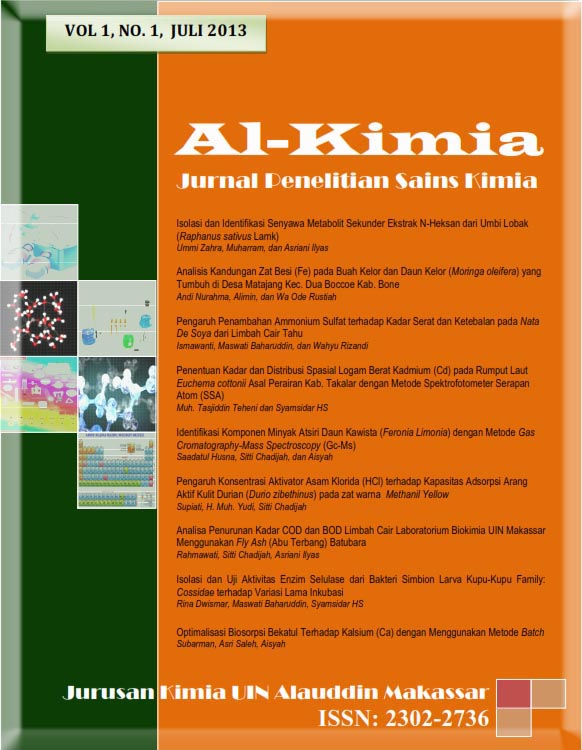Identifikasi Komponen Minyak Atsiri Daun Kawista (Feronia limonia) dengan Metode Gas Cromatography-Mass Spectroscopy (GC-MS)
Abstrak
Indonesia has a vast variety of plants species which largely unexplored. Several researches have conducted to explore the potentials of the plants. However, the chemical constituents of Kawista plant have not been widely investigated. This study aimed to identify the components of the essential oil from Kawista leaves (Feronia limonia). This study consisted of two stages, namely the extraction of essential oil by distillation method and the analysis of the essential oil components by GC-MS method. The results showed that there are sixteen volatile components in the essential oil of Kawista leaves (Feronia limonia). They are 3-pentanol, 1-methyl siklopenatnol, 3methyl siklopentanol, 1,1-dimethyl 2-propenol, 4-tujanol, 2 methyl 3buten-2-ol, 1-(2-oksiranil etanon, 2-heksanon, 1-butanone cyclohexyl, 3-methyl 2 pentanon, 1-heksanal, 2-heksenal, 1-ethyl acetaldehyde, 2,5-tetrahidrodimethyl furan and γ-terpinen.
##plugins.generic.usageStats.downloads##
Referensi
Absar, Qureshi A, Kumar K dan Omer Shaista, 2010, Feronia Limonia A Path Less Travelled, IJRAP, 1 (1) 98-106, http.www.ijrap,net (16 Februari 2012).
Agusta, Andria. Minyak Atsiri Tumbuhan Tropika Indonesia. Bandung: Penerbit ITB, 2000.
Anton Apriyantono, B. Kumara, 2004, Identifikasi Character Impact Odorants Buah Kawista (Feronia Limonia). Jurnal Teknologi dan Industri Pangan Vol XV No.1. IPB (10 Februari 2013).
Creswell, Clifford J. Olaf A Runquist, dan Malcolm Campbell, 1982, Analisis Spektrum Senyawa Organik Edisi kedua. Bandung: Penerbit ITB.
Dian Mutmainnah, 2010, Sifat Fisis dan Mekanis Kayu Kawista (Feronia acidissima Correa) Asal Bima Nusa Tenggara Barat” Skripsi Sarjana, Fakultas IPB, Bogor.
Gandjar, Ibnu Gholib dan Abdul Rohman, 2012, Kimia Farmasi Analisis. Cetakan IX. Yogyakarta: Pustaka Pelajar.
Guenther, Ernest, 1990, Minyak Atsiri Jilid I. Terj. S. Ketaren, Jakarta : UI Press.
Gunawan, D dan Mulyani, 2004, Ilmu Obat Alam (Farmakognosi) Jilid I, Jakarta: Penebar Swadaya.
Gupta, M.K. dan Ramesh Kumar Singh, 2011, Preliminary Pharmacognostical Investigation of Feronia Limonia Leaves, IJPI’s Journal of Pharmacognosy and Herbal Formulations. Vol 2. No.7, http://www.ijpijournals.com (27 Februari 2012).
Hardjono Sastrohamidjojo, 2004, Kimia Minyak Atsiri, Yogyakarta: Gajah Mada University Press.
Jain, Mahendra, Ashish Trivedi dan S.H. Mishra, 2010, TLC Determination of Marmesin, A Biologically Active Marker from Feronia Limonia L, American Journal of Plant Sciences 1, 12-16. http://www.SciRP.org/journal/ajps).
Khopkar, S. M, 2008. Konsep Dasar Kimia Analitik, Jakarta: UI Press. Khairani, Lily Piliang. “Isolasi dan Analisis Komponen Minyak Atsiri Dari Daun Sembung (Blumea Balsamifera) di Daerah Sunggal Kotamadya Medan dengan GC-MS dan Uji Antibakteri.” Tesis, Fakultas MIPA, Universitas Sumatera Utara, Medan, 2011.
Morton, Julia F, 1987, Fruits Of Warm Climates. Miami: Florida, http://www.hort.purdue.edu/newcrop/wood-apple.html (15 Februari 2012).
Panji, Tri, 2012, Teknik Spektroskopi Untuk Elusidasi Struktur Molekul. Yogyakarta: Graha Ilmu.
Sukamto, L. A, 1987, Morfogenesis beberapa Eksplan Kawista (Limonia acidissima L.) Yang ditumbuhkan secara kultur Jaringan. Dalam Prosiding Heyne, K. Tumbuhan Berguna Indonesia (Terjemahan) Jilid III. Jakarta: Balai Penelitian dan Pengembangan Kehutanan Departemen Kehutanan.
Supratman, Unang, 2006, Elusidasi Struktur Senyawa Organik, Bandung: FMIPA UNPAD.
McNair, H dan Bonelli E. J, 1988, Dasar Kromatografi Gas Edisi ke-5, Terjemahan oleh K. Padmawinata, Bandung: Penerbit ITB.
Robinson, Trevor, 1995, Kandungan Organik Tumbuhan Tinggi, Terjemahan oleh K. Padmawinata, Bandung: Penerbit ITB.
Senthil, Kumar A, et al., eds. 2010, Chemichal constituents and antibacterial activity of the leaf essential oil of Feronia limonia Indian J Microbiol. http://www.proquest.com (11 Janari 2012).
Verheji EWM , Coronel RE, 1997, PROSEA Sumber Daya Hayati Asia Tenggara 2, Buah-buahan yang Dapat Dimakan. Jakarta. PT Gramedia Pustaka Utama.
Authors who publish with this journal agree to the following terms:
1) Authors retain copyright and grant the journal right of first publication with the work simultaneously licensed under a Creative Commons Attribution License that allows others to share the work with an acknowledgement of the work's authorship and initial publication in this journal.
2) Authors are able to enter into separate, additional contractual arrangements for the non-exclusive distribution of the journal's published version of the work (e.g., post it to an institutional repository or publish it in a book), with an acknowledgement of its initial publication in this journal.
3)Authors are permitted and encouraged to post their work online (e.g., in institutional repositories or on their website) prior to and during the submission process, as it can lead to productive exchanges, as well as earlier and greater citation of published work (See The Effect of Open Access).


